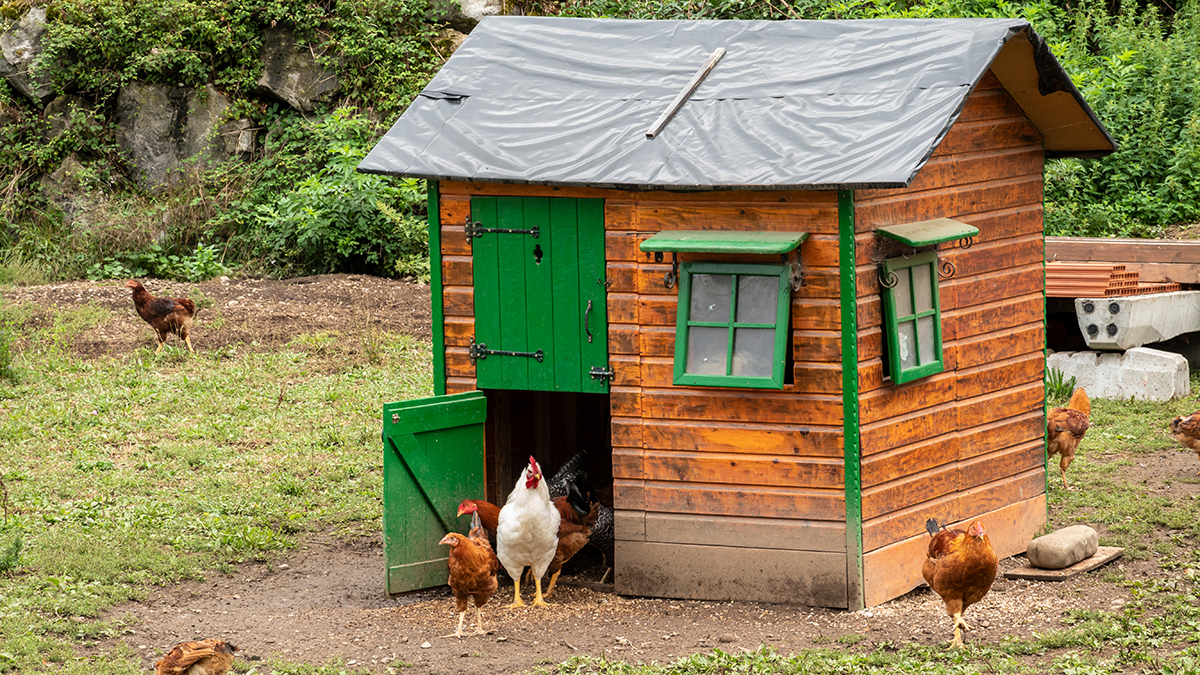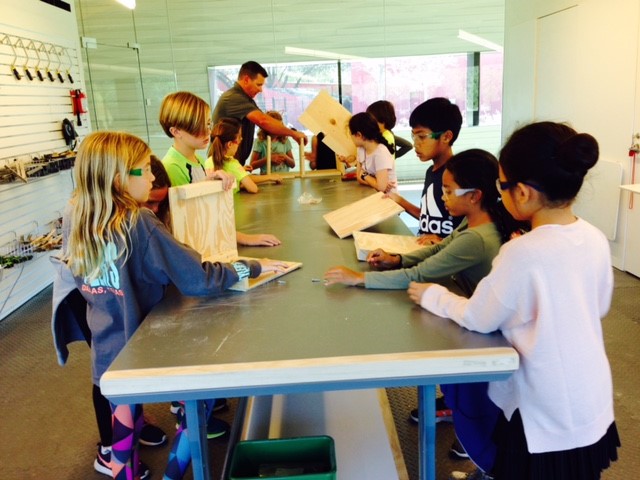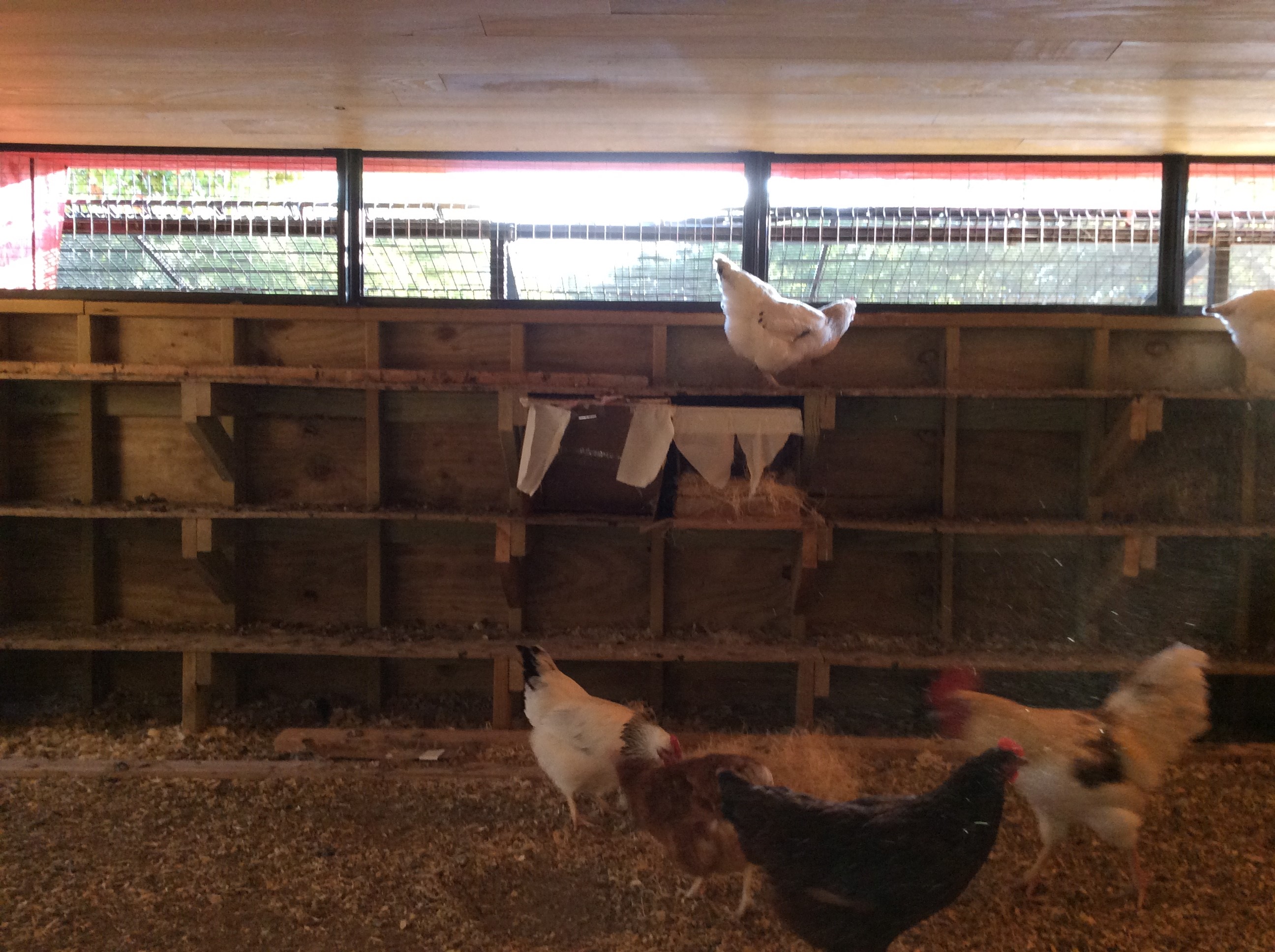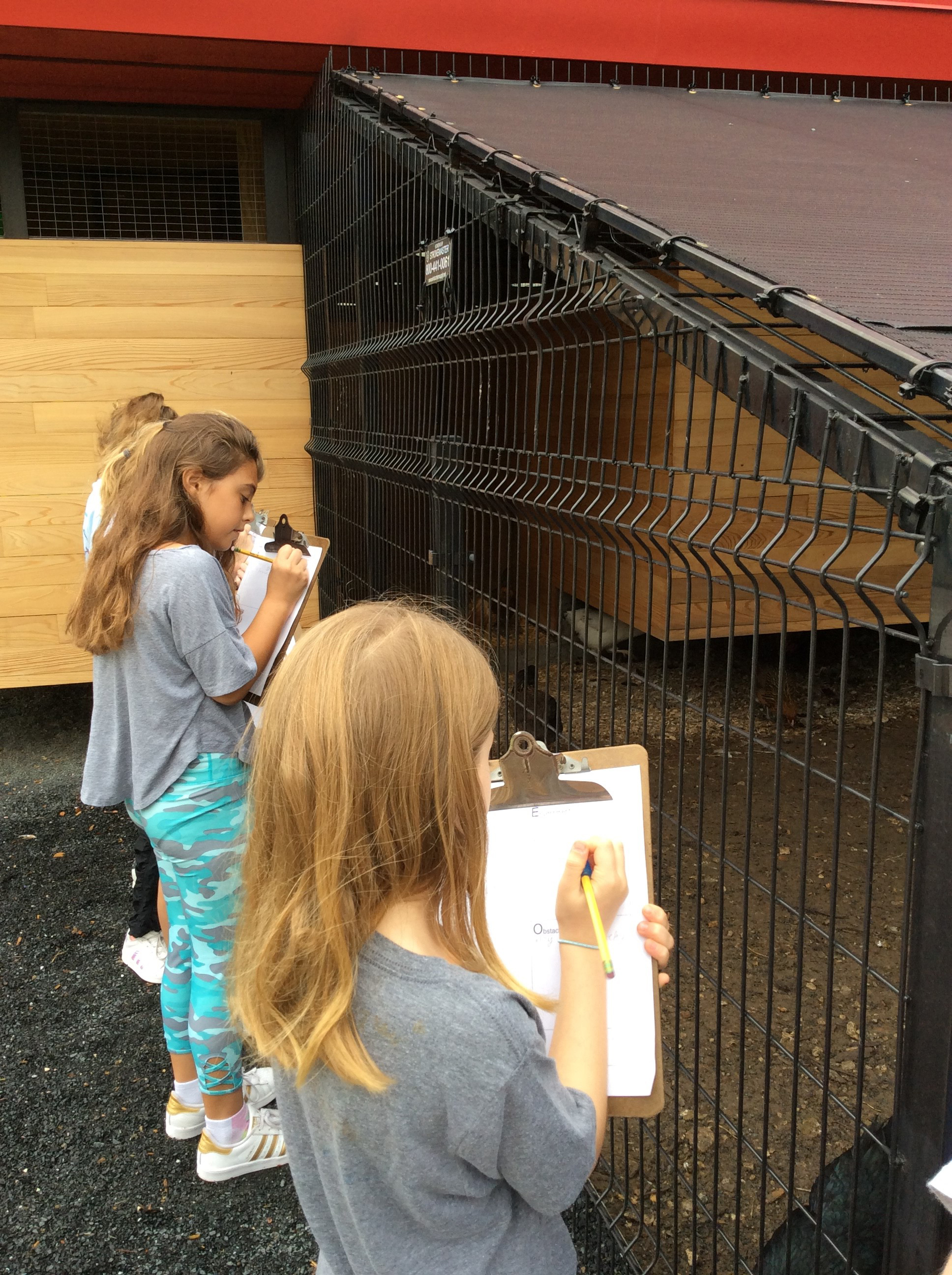feature
Chicken-Centered Design
Fourth graders experience design thinking in the barnyard
Science and Children—January/February 2022 (Volume 59, Issue 3)
By Jody Stout, Rob Rouse, Jonathan Malesic, and Katie Krummeck

Safety Sidebar
We’ve had an established chicken program at our school for 51 years, so our students were well versed in the safety routine (e.g., hand washing, shoe covers, etc.). For more information on raising chickens in schools, including safety requirements, see these Resources:
The Ultimate Guide to Keeping Chickens in School: https://www.backyardchickencoops.com.au/blogs/learning-centre/the-ultimate-guide-to-keeping-chickens-in-school
A Guide to Raising Chickens in District School Gardens: https://osse.dc.gov/sites/default/files/dc/sites/osse/publication/attachments/Chicken%20Guide_0.pdf
Design thinking—a human-centered approach to problem solving—is a process by which K–12 teachers engage students in solving relevant issues that occur in their schools (Carroll et al. 2010; Diefenthaler et al. 2017). In this article, we describe a project in which fourth-graders used design thinking to solve an unexpected issue related to a much-anticipated class project. In a unique turn of events, students used the principles of design thinking to solve a chicken-related problem rather than a human-related problem. Participating in this process allowed students to think critically, build creative confidence, and engage in science and engineering learning.
Context
The design thinking project we describe here took place at an independent co-educational day school for students in grades preK–4. For nearly 50 years, each fourth-grade class at the school has participated in an interdisciplinary project designed to promote students exploring the risks and returns of private enterprise, the consequences and outcomes of choice, and the demands and rewards of accountability. Specifically, the project calls for fourth graders to create and run a business to sell the eggs produced by the school’s flock of chickens, an endeavor that spans the course of the entire school year. This complex effort sets the stage for authentic learning experiences because students must take on leadership roles (e.g., president, vice-president), participate on committees to craft agendas and make schedules, and do the work of business owners (e.g., create egg-collection crews; care for chickens by giving them food and water; and collect, wash, package, and sell eggs). Many of the eggs that students collect and package are purchased by parents in the car line before and after school. The project serves as a culminating and transformative experience for fourth graders as it is one of the final classwide activities that they participate in during their time at the school. In this article, we report on a design thinking project that took place across approximately nine 30-minute classes over the first three weeks of instruction.
An Unexpected Problem Appears
Prior to the start of the school year during which this project occurred, the school constructed a barn complete with a brand-new henhouse to shelter the chickens. However, with the new henhouse came an unexpected problem. Early in the school year, students found that few chickens laid their eggs in the henhouse’s dedicated nesting boxes. Instead, some chickens laid their eggs on the concrete floor and others laid their eggs under an overhang in the barnyard outside the henhouse. The result was that the eggs were difficult to collect and many were cracked or broken and therefore could not be sold. In order to salvage the project and save the business, students found they had to solve a problem: Find a way to increase chicken egg production.
Importantly, the problem was situated in a highly anticipated project and was therefore highly relevant to every fourth-grade participant. Equally as important, the stakes were high. The students recognized that the burden of solving the problem rested on their shoulders. If they failed to solve the problem, they could lose the chance of participating in the project altogether.
Fortunately for the students, their teacher, Ms. Jody, was in a position to facilitate the use of design thinking to solve the problem. She had recently been trained in design thinking by members of the Stanford d.school’s K–12 Lab. In addition, the school had recently contracted with a design thinking expert at a nearby university to regularly consult with teachers and provide professional development related to design thinking throughout the school year. Indeed, when the chicken egg problem appeared, Ms. Jody and the outside expert, Ms. Katie, were already in the process of brainstorming ideas for a design thinking project. In the absence of an expert, there are many available design thinking resources (see Online Resources for a list of institutions that provide open-source resources related to design thinking for K–12 teachers).
So the question became, “Could the principles of design thinking work for chickens, too?” Ms. Jody and her students reasoned that even though the problem involved chickens, not humans, there were observable behaviors to design for, so the process was relevant. Thus, with guidance from Ms. Jody and Ms. Katie, students used the methods of design thinking to approach solving the problem. The actions students took are described next.
Part I: Build Empathy
The first step in using design thinking to solve a problem is to immerse yourself in the context and shape your own understanding of the system. The best way to do this is to build empathy for the people (or in this case, the chickens) who are experiencing a problem. Accordingly, Ms. Jody, with the aid of the fourth-grade teachers, launched the design thinking exercise by asking the students to conduct research to understand how chickens typically react to a variety of nesting conditions (see Supplemental Resources for the handout used to scaffold this process). Students watched videos, read articles, and compared and contrasted what they learned with what they knew about the design of the new henhouse. During this activity, Ms. Jody and her fellow teachers connected to several English language arts standards (e.g., RI.4.1, refer to details and examples in a text when explaining what the text says explicitly; RI.4.9, integrate information from two texts on the same topic in order to write or speak about the subject knowledgeably). Performing this research caused the students to question some of their assumptions about what the chickens needed (e.g., an enclosed private space) and helped them develop informed hypotheses about what might be going wrong in the henhouse. Additionally, conducting this research helped students become aware of chickens’ needs, behaviors, and reproductive cycle (connecting to performance expectation (PE) 4-LS1-1). Before interacting with the chickens, Ms. Jody emphasized that working with live animals is a big responsibility and that students should act with respect toward the chickens and follow all safety procedures (e.g., washing hands, wearing shoe covers) when around the chickens.
Next, clipboards in hand, the students went outside into the barnyard to observe the chickens in their own habitat. Armed with new information about what typical chickens need and want in their nesting environment, the students spent time methodically observing the chickens and capturing notes and sketches detailing the chickens’ behavior. To facilitate this process, Ms. Jody designed an observation sheet for the students. Using AEIOU as a mnemonic, the students aimed to observe the chickens’ Actions, how they responded to their Environment, how they Interacted as a flock, and whether they encountered Obstacles. Finally Ms. Jody encouraged her students to pose “U wonder” questions based on their observations (see Supplemental Resources for the handout used to scaffold this process). As students made observations, Ms. Jody regularly reminded them that they should record what they noticed about the chickens’ behavior rather than predict what they thought the chickens needed. After several sustained observation sessions, the students gathered in teams to participate in the science and engineering practice (SEP) of analyzing their data to identify opportunities to improve the nesting conditions in the henhouse. At the same time, students made detailed observations of the system under study, connecting to the crosscutting concept (CCC) of systems and system models. (Table 1 provides a summary of student actions and how those actions connect to components of the Next Generation Science Standards for Part I.) Ms. Jody then placed students into heterogeneous small groups and guided them to identify observations that were common across group members.

Part II: Define the Problem and Propose Solutions
After building empathy for the participants, the next step in the design thinking process is to define the problem and propose potential solutions. This step aligns with PEs 3-5-ETS1-1 and 3-5-ETS1-2. To begin this work, Ms. Jody directed each small group to collaborate to identify the problem and propose a solution that included a sketch and a brief description of their idea. Based on their initial research and barnyard observations, the fourth-grade students identified several issues with the henhouse design that they believed were causing the chickens to lay their eggs in undesirable locations. Students realized that while chickens do not necessarily need privacy, they do need a safe, secure, and warm place to lay their eggs. From these insights, students crafted “how might we” questions to guide them as they generated solutions. These “how might we” questions included: How might we make sure the chickens are warm? How might we make sure the eggs are safe? Guided by these questions, students brainstormed a variety of solutions, engaging in the SEP of designing solutions. (Table 2 provides a summary of student actions and how those actions connect to components of the NGSS for Part II.) Next, they pitched their ideas to their classmates to get feedback. After several rounds of feedback, the students landed on three ideas they believed might solve the problem—nesting boxes that would create safe, secure spaces for the chickens to lay; curtains to separate the nesting area from the rest of the henhouse; and a lip that would stop the chickens from inadvertently kicking their eggs out of the boxes. Throughout this process, Ms. Jody monitored how students gave feedback. By selecting several promising possible solutions to the egg-laying problem to prototype, students connected to the CCC of structure and function.
Working in small groups allowed each student to play an important role in this part of the project. When the students eventually proposed a solution to the problem, they had each contributed research, observations, ideas, and labor. The variety and scope of the project meant that every student had the opportunity to contribute according to their unique strengths, whether reading a website, leading a discussion, creating a sketch, or giving a classmate feedback.
Part III: Prototype and Test
Once participants generate ideas for solving the problem at hand, the next step in the design thinking process is to prototype and test those ideas. With this in mind, Ms. Jody’s students created a variety of prototypes using cheap and accessible materials (e.g., cardboard, muslin, paper). During this activity, Ms. Jody and her fellow teachers connected to several mathematics standards (e.g., 4.MD.A.1, know relative sizes of measurement units within one system of units; 4.MD.A.2, represent measurement quantities using diagrams). Next, students tested their prototypes in the henhouse. Some prototypes failed. This taught students to persist when solving a problem and to troubleshoot features of their design. After testing prototypes, Ms. Jody led a discussion to gather information about what worked and what did not. These student actions align with PE 3-5-ETS1-3. (Table 3 provides a summary of student actions and how those actions connect to components of the NGSS for Part III.)
After several rounds of testing, observation, and iteration, the students found that one of their nesting box designs worked. Ms. Jody reported, “They were so excited. They would come in [from the henhouse] exclaiming, ‘They were in the box! The eggs were in the box!’ So, students knew that they had been successful, as they directly witnessed the success of their design. When they saw an egg in the cardboard box, they had earned the right to say, ‘We did it! This is it. This is the answer.’” During the process of prototyping and testing, the students also realized some of their proposed solutions were not helpful and discarded those ideas, including the separation curtain. Ultimately, discovering eggs in their self-designed nesting boxes was a reward of immeasurable consequence—in terms of both pride and the determination to continue.

The students’ success opened the door to further iterations of prototyping and testing when they moved from low-resolution materials to high-resolution materials (i.e., more durable materials). Next, through a collaboration with the woodworking teacher, they created several wooden nesting boxes and placed them in the henhouse. The chickens immediately began laying eggs in the new nesting boxes and egg production increased tremendously. The students knew that their design would create safe and secure spaces for the chickens to lay within the existing infrastructure of the henhouse. They were ready to implement their ideas at scale.
In order for the students to scale up, they needed support from the school’s administration in the form of funding. The students put together a compelling pitch for the money they needed to build the remaining nesting boxes by telling the story of their design work—their initial research, their fieldwork, their problem definition, brainstorming, early prototyping and the process of testing and refining their ideas. Ms. Jody summarized the students’ stance concisely when she said the students argued, “This is a problem, I can prove it to you. It has to be fixed, and we know how to fix it. And look: this is exactly what it will look like.” Students formally proposed their solution to the school’s leadership team with a PowerPoint presentation and two high-resolution prototypes, participating in the SEPs of engaging in argument from evidence and communicating information. They successfully convinced the leadership team to fund the project and to allow them to build and install the new nesting boxes.
With the funding secured, the students worked with the math teacher and the woodworking teacher to safely fabricate and install the nesting boxes. The chickens were more comfortable with their laying conditions and stopped laying eggs in undesirable places, connecting the project to the CCC of cause and effect. The students had solved the problem, saved the project, and improved life for the chickens.
Connecting to Science, Engineering, and 21st-Century Skills
The project we describe in this article demonstrates the utility of the design thinking process for solving authentic and challenging problems in elementary school classrooms. In addition, the project also illustrates how engaging in the design thinking process empowers students to take ownership of a project and drive it from beginning to end. Finally, the project demonstrates the flexibility of design thinking as a method for connecting to a range of 21st-century skills (e.g., creative confidence and critical thinking) as well as to science and engineering practices and concepts—supporting the notion that design thinking is a useful tool educators can deploy to teach science, technology, engineering, arts, and mathematics (STEAM) learning objectives in integrated and interesting ways (Cook and Bush 2018).
A glance back at some of the actions students took during this project demonstrates how helpful engaging in the design thinking process was for promoting students connecting broadly to the three-dimensional learning outlined in the Next Generation Science Standards (NGSS) (NGSS Lead States 2013). For example, when building empathy, students asked questions, planned investigations, and obtained and evaluated evidence. When defining problems and proposing solutions, students analyzed and interpreted data as well as planned investigations. And when prototyping and testing, students designed solutions, developed models, used mathematics, engaged in argument from evidence, and evaluated and communicated information. Students also connected to a variety of fundamental science and engineering concepts during the project. For example, throughout the three distinct parts, students examined patterns, explored cause-and-effect relationships, investigated systems and the relationships within those systems, and reasoned to understand structure/function relationships. Finally, much of the work that the students engaged in to complete the project were age-appropriate approximations of the actions that engineers take when applying scientific ideas and using technology to solve problems. ●

Online Resources
d.loft: https://dloft.stanford.edu/resources
Design for Change: https://www.dfcworld.com/SITE
Design Thinking for Educators (IDEO): https://www.ideo.com/post/design-thinking-for-educators
Extreme By Design: http://www.extremebydesignmovie.com/
The Future of Stuff Challenge: https://futureofstuffchallenge.org/
K12 Lab at the Stanford d.school: https://dschool.stanford.edu/programs/k12-lab-network
The RED Lab: https://web.stanford.edu/group/redlab/cgi-bin/
Supplemental Resources
Tables 1, 2, 3: https://www.nsta.org/sites/default/files/journal-articles/S%2BC_JanFeb_2022/Rouse/Rouse_tables.pdf
Download the research and observations documents at https://bit.ly/3f2kFk6.
Jody Stout (jstout@thelampligherschool.org) is the media center coordinator at The Lamplighter School in Dallas, Texas. Rob Rouse (rrouse@smu.edu) is a clinical associate professor at Southern Methodist University in Dallas. Jonathan Malesic (jon.malessic@gmail.com), author of the book, The End of Burnout, is an essayist and journalist based in Dallas. Katie Krummeck (katie.krummeck@akdn.org) is a Global Innovation & Design Advisor with the Aga Khan Foundation and is based in Portland, Oregon.
Biology Engineering Environmental Science Interdisciplinary Technology


